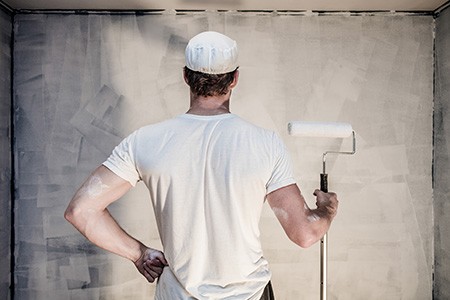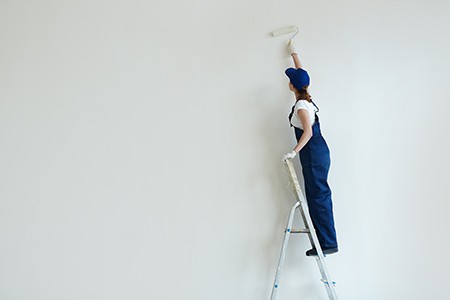Can Ceiling Paint Be Used on Walls? Yes, If You Like It
Author: Omar Alonso | Editor: Omar Alonso
Review & Research: Jen Worst & Chris Miller

You've decided to paint the living room walls in your home. As you rummage through the cans of paint in your garage, you realize you don't have any wall paint left. Great, now what? The can of ceiling paint catches your eye. It's full. Can ceiling paint be used on walls?
It's the right color you settled on, and it sure would save you on your remodeling budget if you could slap in on the walls instead of buying another can of expensive interior wall paint. So, can you paint walls with ceiling paint? Let's find out.
Can Ceiling Paint Be Used on Walls?
The good news is, yes. You can use that can of ceiling paint on your interior walls. It's not the best choice, but it will do. Ceiling paint also works great as a primer, giving your wall paint a longer lifespan. Whichever way you want to use it, ceiling paint does have some value when used to paint interior walls.
What is the Difference Between Wall Paint & Ceiling Paint?

So, if you can use ceiling paint on walls, why bother with wall paint at all? What's the difference between the two, and is it worth buying interior wall paint for the job? Will it give you a better finish, or should you just go with the ceiling paint for the job? Let's look at the difference between the two.
Price
First, let's talk about your budget. Using ceiling paint on walls will usually save you a bundle of money on your project because wall paint is more expensive. You'll find most wall paint brands are 15% to 20% more costly than ceiling paint for most standard paint can sizes.
It depends on the type of wall paint you use, with latex paints being the same price or a little more affordable than ceiling paints. However, ceiling paint requires fewer coats to cover up marks and has better coverage, so you'll save if you're using it on a cover-up job.
Coverage
You get the same coverage from a single coat of ceiling paint that you would from two or three coats of wall paint. The better coverage makes it easier to hide marks, and you don't need as much paint to finish the job, making it a good choice for homeowners on a budget.
Viscosity
Viscosity describes the thickness of the paint, and ceiling paint is far more viscous (meaning it's thicker, not thinner) than wall paint, but what does that mean for your project? Ceiling paint provides better adhesion to the surface over wall paint.
There’s more solids in the paint, and it won't drip or splatter as much as wall paint when rolling it on or create the roping effect you often see when rolling paint on a wall. You get a smooth application, and the additional viscosity means it works great as a primer coat for wall paint on all surfaces, including walls and doors.
If you have areas in the home with mold stains, ceiling paint covers it with a single coat. The same task with wall paint could take several coats to achieve the same finish. The optimal viscosity for paint is 100 centipoise, and neither wall paint or ceiling paint strays from that very far.
Durability
Ceiling paint isn't as durable as wall paint. It's meant for painting the ceiling, so it's unsuitable for wiping down like wall paint. For instance, if you get a smudge on the wall from your kid's greasy hand wiping it, ceiling paint makes it hard to remove the stain, where it just wipes off of wall paint.
Colors
Can ceiling paint be used on walls? Yes, if you like the color. The ceilings are usually white and don't have any decorations. So, you won't find as many color options in ceiling paints. However, a paint shop can add pigments to the ceiling paint and mix it to your color specifications if you're buying new cans. If you go with white you don't need to worry about paint drying lighter or darker than intended.
Finishes For Ceiling Paint

Most brands of ceiling paint focus on products with a flat finish. A few are available in eggshell, but it's less common a finish than flat. This is because matte finishes don't reflect light, as well as eggshell types. As a result, they don't draw attention away from the walls.
Eggshell Finish
A safe bet if you're unsure which finish suits your walls. It has a soft appearance ideal for living spaces like the bedroom, hallway, and living room. It has a low-gloss look and is reflective but not as shiny as semi-gloss or glossy finishes.
Flat Finish
A flat finish, also known as "matte," provides a smooth texture for the wall with a uniform look. It's the better choice for formal spaces in the home, such as dining rooms, kitchens, and home offices. Matte finishes have minimal light reflection, helping to hide imperfections in the wall and ceiling, such as dents, holes, and patchwork.
Should I Use an Eggshell or Flat Finish on My Walls?

Your choice to use a flat or eggshell finish on your walls depends on your preference. Eggshell is a good choice for trim in foyers and kitchens, providing a smooth, elegant finish to the surface. It's a good choice for high-traffic areas in the home, like hallways and other low-light areas.
Flat finishes aren't a good choice for high-traffic areas because they don't offer the same resistance to stains, handprints, debris, and dust you get with eggshell finishes. Flat finishes aren't a good choice for the bathroom since they tend to develop mold and mildew more than eggshell finishes.
Whether you're touching up rooms in your house or in multi-room renovations, understand that the more sheen in the paint, the more light it reflects and the more it shines. Eggshell usually has more sheen to it, making it easier to clean than flat paint finishes. For low traffic areas, ceiling paint can make for great paint alternatives for interior walls.
Can Ceiling Paint Hide Wall Marks?
As discussed, ceiling paint has a higher viscosity than wall paint. As a result, it makes it the better choice for covering up stains, marks, and mildew/mold. Its excellent blocking characteristics also make it ideal for a primer, reducing the coats you need with wall paint to cover up marks in high-traffic areas around the home.
Ceiling paint effectively covers all types of wall stains, and it's a great choice for homeowners that want to cover up stains from cigarette smoke, handprints, cooking spatter, and scuff marks. Using it as a primer is a great way to give your wall a fresh start and a clean look after finishing it with wall paint. Just make sure you know how many coats of primer you need on new drywall.
Since most ceiling paints have a flat or matte finish, they're a great choice for covering fillers used to patch up dents and holes in walls. After a coat of ceiling paint, the patchwork isn't visible anymore, giving the wall more continuity in its visual aesthetic. You won't notice any contrast in the newly painted surface.
However, we recommend against using ceiling paint, especially those products with flat finishes in the kitchen or bathroom. They make it easier for mold to stain the surface, and you're better off using latex wall paint with an eggshell finish in these areas.
FAQ’s Regarding Using Ceiling Paint on Walls

When the topic of can ceiling paint be used on walls comes up, there’s always a handful other questions that arise. Let’s cover those now since they’re so common you might be wondering as well.
Is Ceiling Paint a Good Primer?
Yes, ceiling paint acts as a good primer for walls, trim, and doors. It's easy to sand and great for hiding imperfections in the wall, such as dents and cracks. Its high viscosity and good coverage make it ideal for a primer.
Is Ceiling Paint the Same as Flat White Paint?
Ceiling paint usually has a flat or "matte" finish. You get a low-sheen surface, providing a uniform, smooth look, and texture on walls in the home. Ceiling paint spreads well, and you'll get fewer drips and runs when using it on walls.
Can I Mix Ceiling Paint & Wall Paint?
They'll mix if you have the same finish for both the wall and ceiling paints. Mixing the paint allows you to alter its color to your preferred look. Since most ceiling paints are white, adding them to wall paints lightens the color.
If you're unsure of which paint you have, pour a small sample of each, mix them, and apply them to the wall. Let it dry and see if it holds. Maybe you decide to paint your basement ceiling the same color as the walls and you can mix it all together.
Can I Use Wall Paint on My Ceiling?
While you can use ceiling paint on walls, we recommend against using wall paint on the ceiling. Wall paints have a lower viscosity, meaning they will drip. If you have carpets in the room, the drips will ruin them. If you must use wall paint on the ceiling, ensure you lay drip mats and paint section-by-section, ensuring it's dry before moving the mats.
Can I Paint Doors With Ceiling Paint?
Yes, you can paint doors with ceiling paint. You can use it as the final coat or as a primer. However, it's not the best choice for doors as its low durability means it will stain and leave handprints. You should take similar concerns into consideration when using exterior paint inside.
Key Takeaways Regarding Using Ceiling Paint on Walls

Can you use ceiling paint on walls? Let’s recap the main points we’ve made above to help solidify your new knowledge:
- You can use ceiling paint on your walls.
- Ceiling paint has better viscosity than wall paint, giving you better coverage and the ability to hide marks and stains.
- The higher viscosity also requires fewer coats to finish the job.
- You need to be careful if the paint froze in storage. Mix it well and test it. If needed, you can mix it down with fresh paint.
- Ceiling paint is usually more affordable than wall paint, allowing you to reduce your project costs.
- Ceiling paint acts as a great primer before using wall paint to finish the job.
- The flat finish of ceiling paint and its lower durability means it stains easier than wall paint.
- Don't sleep in the room immediately after painting.
While you definitely can use ceiling paint on walls, you need to realize that it’s going to pick up hand smudge marks and scuffs much more easily. White may not be the best paint color for east facing rooms if you're into that kind of decor decision-making.
So, Can Ceiling Paint Be Used on Walls?
The question is can ceiling paint be used on walls and yes, you can. It can be used as a primer or the main coat. It will have a flat finish, meaning it’ll pick up smudges more easily, and will probably be white in color which makes matters worse. But if that’s what you were going for, then all is well.



